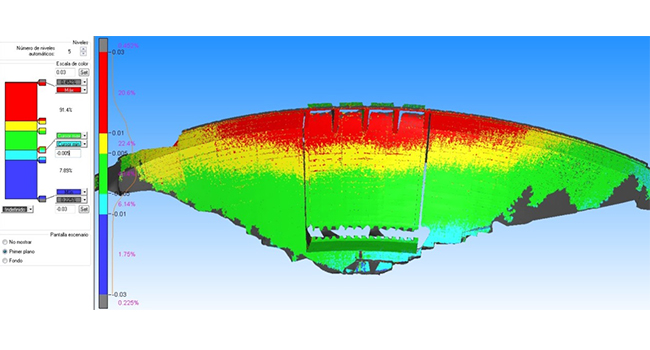
Resumen
Los avances que se han producido en los últimos años, en el campo de la instrumentación electrónica, han permitido su aplicación en numerosos campos de la ingeniería civil. En concreto, una aplicación que puede beneficiarse de los mencionados avances es la auscultación de movimientos, tanto del terreno como de las estructuras. En este artículo se exponen dos de las últimas técnicas que se están aplicando a la medición de movimientos en estructuras: El GPS diferencial con algoritmos de filtrado (DGPS filtrado) y el Láser-escáner Terrestre (Terrestrial Laser Scanner, TLS).
Dos son las características que diferencian amabas técnicas. Mientras el DGPS permite la medición en continuo, el TLS realiza sus mediciones por campañas, de igual forma que se realizaría aplicando la nivelación o la colimación angular. La segunda característica que los diferencia es la precisión obtenida. En el caso del DGPS se consigue apreciar movimientos del orden del milímetro, mientras que la precisión del TLS está cercana a los 3 milímetros, si bien se espera que evoluciones futuras mejoren la actual precisión hasta alcanzar el milímetro.
Al margen de sus precisiones, es de destacar que ambas técnicas pueden ser aplicadas con éxito a la auscultación de movimientos de estructuras y elementos relacionados con las mismas, como por ejemplo taludes, obras auxiliares, etc.
Palabras clave: DGPS filtrado, Láser-escáner Terrestre, TLS, auscultación, control de movimientos en estructuras.
Abstract
The advances that have occurred in recent years, in the field of electronic instrumentation, have allowed their application in many fields of civil engineering. In particular, the auscultation of movements of both the terrain and the structures can benefit from the aforementioned advances. In this article two of the latest techniques that are being applied to the measurement of movements in structures are exposed: Differential GPS with filtering algorithms (filtered DGPS) and the Terrestrial Laser-scanner (TLS).
There are two characteristics that differentiate both techniques. While the DGPS allows continuous measurement, the TLS performs its measurements by campaigns, just as it would be done by applying leveling or angular collimation. The second characteristic that differentiates them is the precision obtained. In the case of the DGPS it is possible to appreciate movements of the order of the millimeter, while the TLS achieves an accuracy of 3 millimeters. Nevertheless it is expected that future enhancements will enhance this performance up to one millimeter in the near future.
Regardless of their precisions, it is noteworthy that both techniques can be applied successfully to the auscultation of movements of structures and elements related to them, such as slopes, auxiliary structures, etc.
Keywords: Filtered DGPS, Terrestrial Laser Scanner, TLS, monitoring, structures movements control.
Autores
Adrián García Sánchez (E.T.S. Ingenieros de Caminos, Canales y Puertos – Universidad Politécnica de Madrid) adrian.garcia.sanchez.aero@gmail.com
Luis Ramos Alcázar (E.T.S. Ingenieros de Caminos, Canales y Puertos – Universidad Politécnica de Madrid) luis.ramos.alcazar@upm.es
David Galán Martín (Canal Isabel II. Área de explotación de Presas y Pozos) dgalanmartin@canaldeisabelsegunda.es
Miguel Marchamalo Sacristán (E.T.S. Ingenieros de Caminos, Canales y Puertos – Universidad Politécnica de Madrid) miguel.marchamalo@upm.es
Rubén Martínez Marín (*) (E.T.S. Ingenieros de Caminos, Canales y Puertos – Universidad Politécnica de Madrid) ruben.martinez@upm.es

Be the first to comment